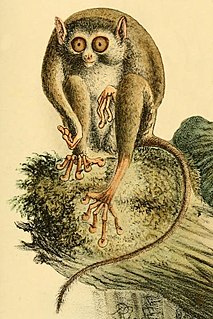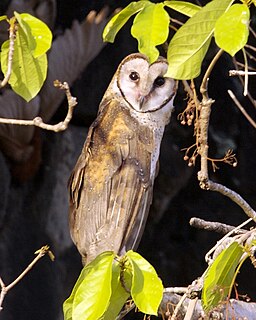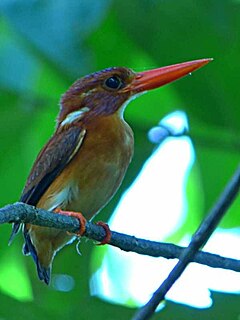
Sulawesi, also known as Celebes, is one of the four Greater Sunda Islands. It is governed by Indonesia. The world's eleventh-largest island, it is situated east of Borneo, west of the Maluku Islands, and south of Mindanao and the Sulu Archipelago. Within Indonesia, only Sumatra, Borneo and Papua are larger in territory, and only Java and Sumatra have larger populations.

Wallacea is a biogeographical designation for a group of mainly Indonesian islands separated by deep-water straits from the Asian and Australian continental shelves. Wallacea includes Sulawesi, the largest island in the group, as well as Lombok, Sumbawa, Flores, Sumba, Timor, Halmahera, Buru, Seram, and many smaller islands. The islands of Wallacea lie between the Sunda Shelf to the west, and the Sahul Shelf including Australia and New Guinea to the south and east. The total land area of Wallacea is 347,000 km2 (134,000 sq mi).

The Sangihe hanging parrot is a small parrot endemic to the small island of Sangihe, north of Sulawesi, Indonesia.

The Sangihe tarsier, also known as Sangihe Island tarsier, is a small primate found on Sangir Island, which is located about 200 kilometers north-east of the island of Sulawesi in Indonesia. In 2008 a population of the Sangihe tarsier was determined to be a distinct species, the Siau Island tarsier.

The elegant sunbird is a large, up to 12 cm long, Australasian sunbird in the genus Aethopyga. The male has an iridescent blue-green crown, shoulder patch and uppertail coverts, yellow bar across lower back, red ear coverts, olive back, yellow throat, red neck collar and yellow below. The female has a yellowish olive upperparts, scaly crown and yellow underparts.

The Sulawesi masked owl is a species of owl in the family Tytonidae. It is endemic to the Indonesian islands of Sulawesi, Sangihe and Peleng. It is listed by the IUCN as being of least concern.

The Sulawesi dwarf kingfisher is a species of bird in the family Alcedinidae that is endemic to Sulawesi island, Indonesia. The species has numerous common names such as Celebes forest kingfisher, blue-crowned kingfisher, Celebes dwarf-kingfisher, and Celebes pygmy-kingfisher.

The Sulawesi shrew is a species of mammal in the family Soricidae. It is endemic to the central and northern provinces of Sulawesi in Indonesia. It is a fairly common species and the International Union for Conservation of Nature has assessed its conservation status as being of "least concern".

The Sulawesi white-handed shrew or Temboan shrew is a species of mammal in the family Soricidae. It is endemic to the island of Sulawesi in Indonesia. It is a fairly common species and the population seems stable so the International Union for Conservation of Nature has assessed its conservation status as being of "least concern".

Beaufort's naked-backed fruit bat is a species of megabat in the family Pteropodidae. Its natural habitat is in caves.

Dobsonia is a genus of megabat in the family Pteropodidae. It contains the following 13 species:

The Biak naked-backed fruit bat is a species of megabat in the family Pteropodidae. It is endemic to Indonesia.

The Sulawesi naked-backed fruit bat is a species of megabat in the family Pteropodidae. It is endemic to Indonesia.

The Panniet naked-backed fruit bat, also known as the De Vis's Bare-backed Fruit Bat and Panaeati Bare-backed Fruit Bat, is a species of megabat in the family Pteropodidae. It roosts in groups, within caves and tree hollows.

The greenish naked-backed fruit bat is a species of megabat in the family Pteropodidae.

The crested roundleaf bat is a species of bat in the family Hipposideridae. It is endemic to Indonesia.

The big-eared roundleaf bat is a species of bat in the family Hipposideridae. It is endemic to Indonesia, known from Kangean Islands, southwestern Sulawesi and Seram Island. It roosts in caves and tree hollows and probably forages in woodland. It is threatened by habitat loss through logging and other human activities.

The Biak roundleaf bat or Geelvinck Bay leaf-nosed bat is a species of bat in the family Hipposideridae. It is endemic to the Biak Islands and Cenderawasih Bay area of Papua Province, located in Western New Guinea, Indonesia.

Andersen's naked-backed fruit bat or Andersen's bare-backed fruit bat is a large cave-dwelling species of megabat in the family Pteropodidae. It is endemic to the Bismarck Archipelago including the Admiralty Islands in Papua New Guinea.

The Sulawesi harpy fruit bat is a species of megabat in the family Pteropodidae. It is endemic to Indonesia.
"This species occurs in Sulawesi, Indonesia. It is also found in Soloi on Buton island in Indonesia. It occurs from sea level up to 2,120m asl or probably higher. This species is not common. In 2002, three individuals were captured at a single locality. Population Trend ↓ Decreasing. It seems to require good forest, but has also been recorded from cocoa plantations. Soloi individuals were caught over a river in undisturbed forest. Roosting habits are not known, but this species is not likely to be a cave dweller. Hunting for sale at market, and forest loss due to expanding agriculture and logging represent major threats to this species. This species is known to occur in Domoga-bone National Park."





















